
Dura-Craft wall assembly
Construction has begun! I knew from experience that the walls would need to be assembled from milled siding pieces. I also expected the pieces to be rough and uneven. Interestingly, though, they went together pretty well. I used my Micromark gluing jig to assemble the pieces that would fit inside it, which worked for all but the two 15″ long pieces.
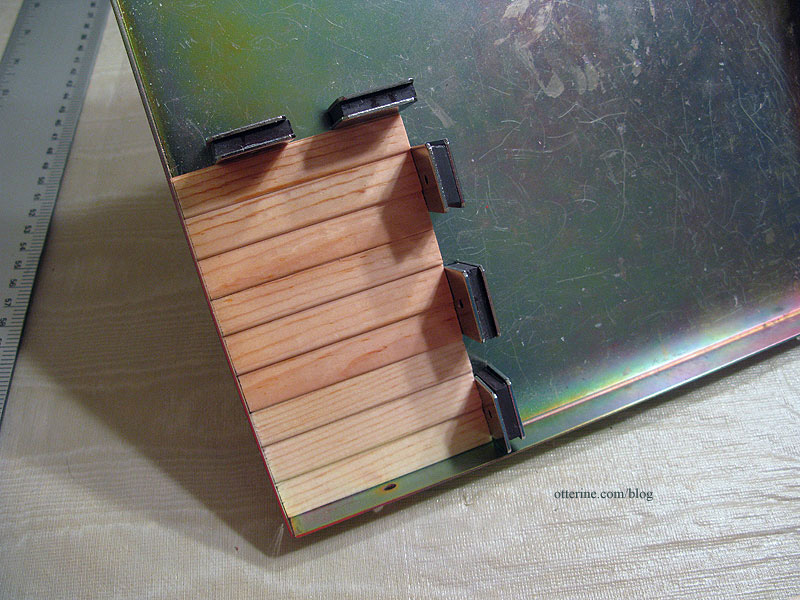
Once those assemblies were reasonably dry, I attached them to the longer boards.
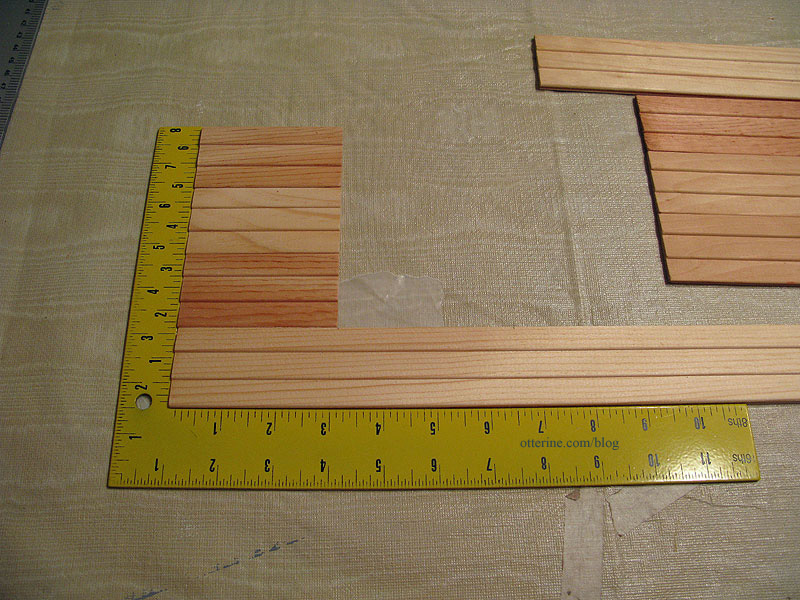
And, of course, I’ve already made changes to the layout. I flipped the pieces on the bottom of the left-hand side wall so that both windows are toward the back. I also decided not to replace the broken pieces and used them as is. I think it will lend itself well to aging the exterior.
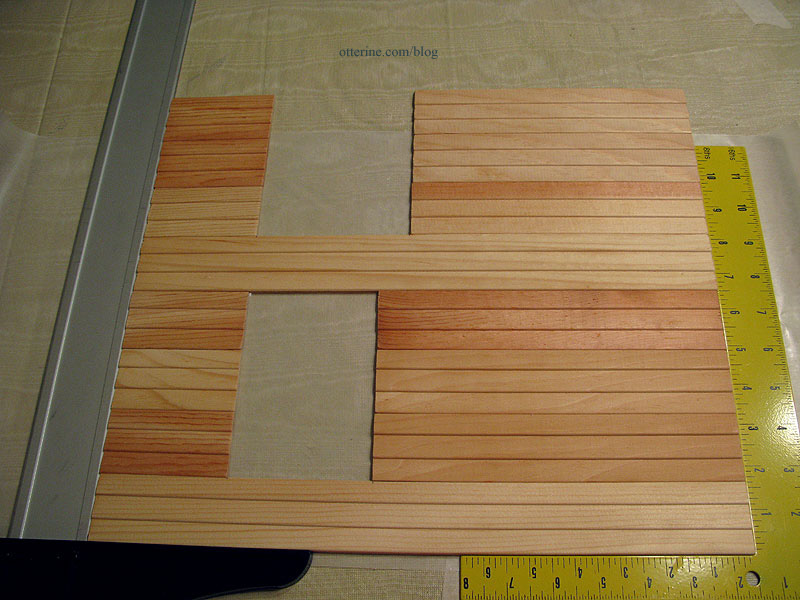
I won’t be using the stairs included with the kit; the layout takes up too much space on the second floor and obscures the view of the front bay window.
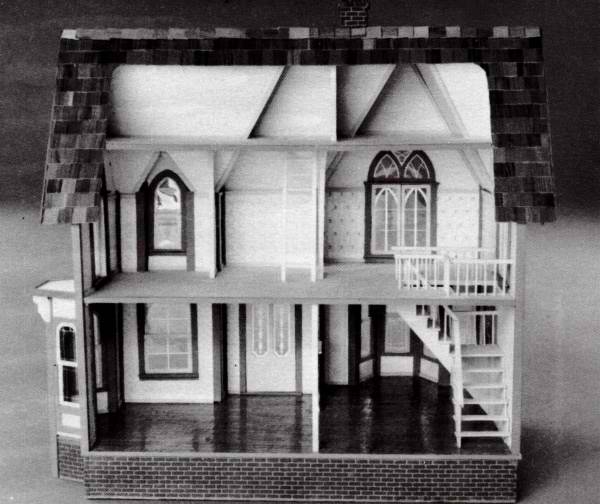
Categories: The Haunted Heritage
July 25, 2011 | 0 commentsHaunted Farmhouse – Dura-Craft Heritage
I grew up in an old white farmhouse that probably looked pretty creepy to others, but I loved it. It was way too cold in the winter, too hot in the summer and had generally outdated décor and musty upstairs rooms. But, it was my first home and even though it no longer stands, I love it still.
These first two photos were taken in 1983, two years after my family moved and just before they used it for fireman training. I didn’t go watch…I couldn’t. It’s overgrown and lush and green…and interestingly, when I dream of it, this is how it appears to me.
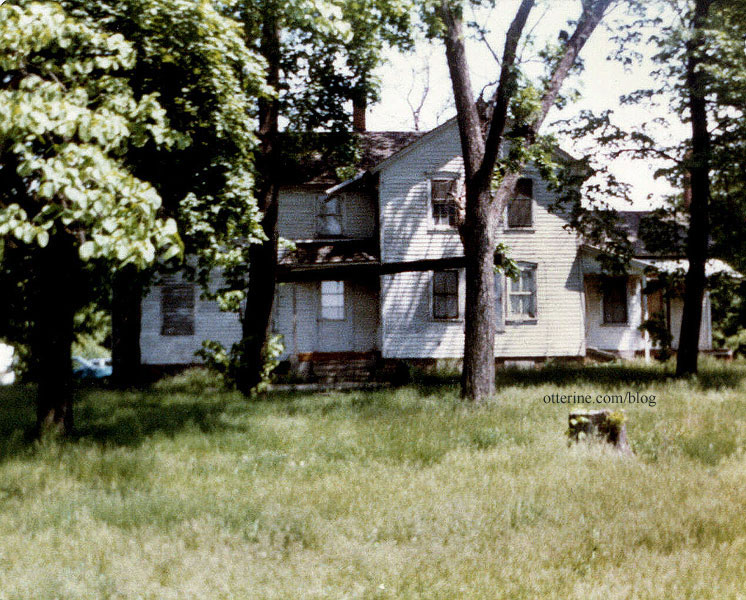
To the left is the mulberry tree where I would gather berries and fell in love with inchworms. To the right is one of the many tall and beautiful walnut trees that I often dream about. They were so lovely.
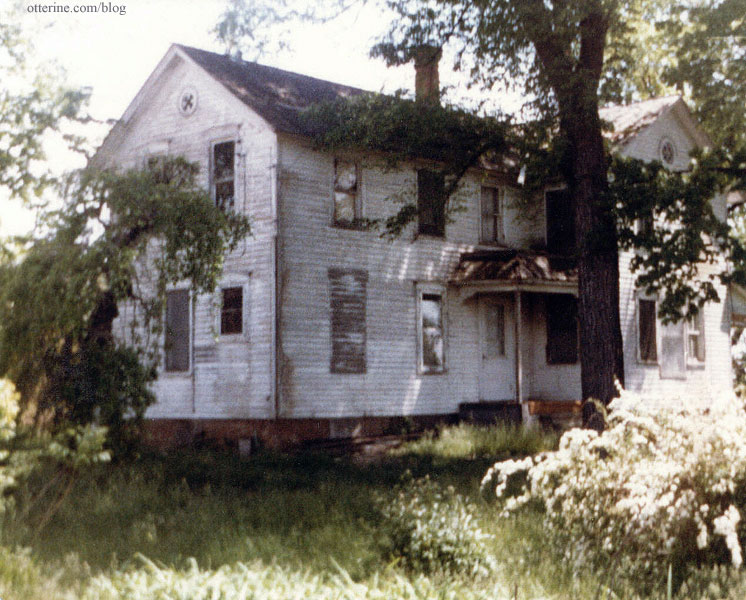
Here is what it looked like when I lived there, in winter. I see it as beautiful, so I suppose that means I was happy there. I think I was for the most part.
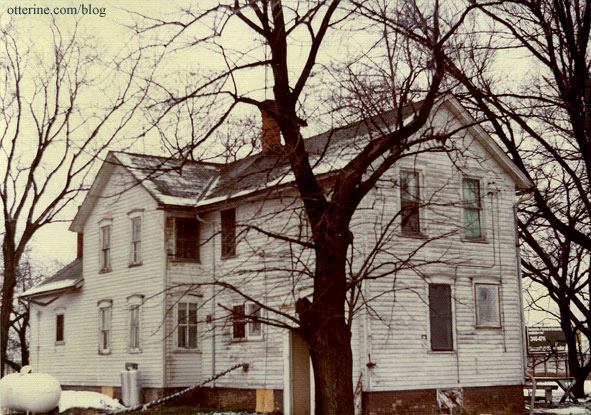
I bought a Dura-Craft Heritage kit sometime ago when I found a good deal on a kit in near perfect condition. I find it interesting that the few pieces broken in the Heritage kit I can replace with pieces I already have from the lost Dura-Craft kit I had a long time ago. Perhaps meant to be…
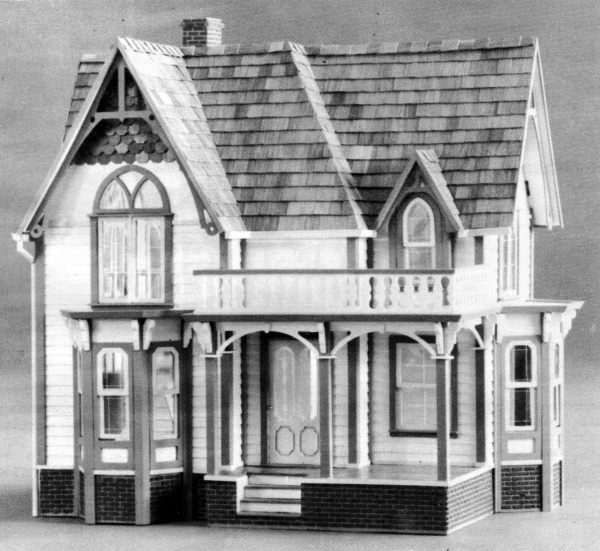
kit photo The other thing this old kit lends itself to is aging. After working with new mdf and laser cut wood, the idea of turning a milled and diecut house into a showroom new mansion makes my head hurt!
I have no idea where this project will end up, and I rather like that open energy. I see in my head an old white farmhouse…not completely dilapidated but in a state that might make you pause to enter…but with a warm albeit old and perhaps historically creepy interior. Maybe a place Jack Skellington might like to visit. Perhaps with these memories attached to the inspiration photo, this project may become more ‘haunting’ than ‘haunted’ by the time I am done.
And, for my first piece…the newly purchased chair from Kris at 1 Inch Minis.
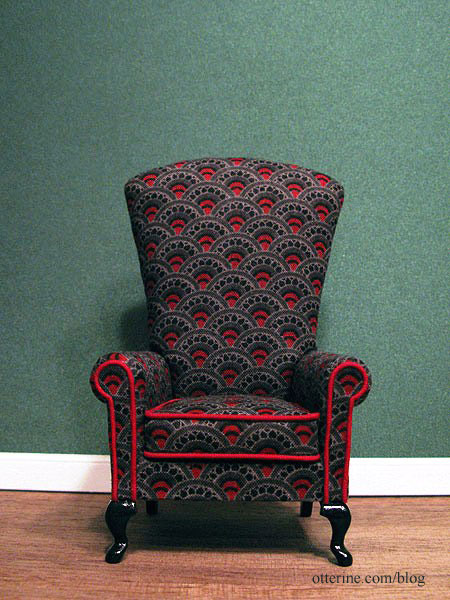
Since I started this mini hobby, I’ve bought a few lots of items and furniture kits that included pieces I never thought I would use. Now I think I might have a home for most of them after all. Since they’re already in hand, that keeps the budget on this project down substantially. This is good especially since there might be a few splurges in other areas. ;]
Three months to Halloween…maybe I can have a good portion done by then…at least enough to take some fun autumn photographs.
Categories: The Haunted Heritage
July 22, 2011 | 0 commentsSnake Plant
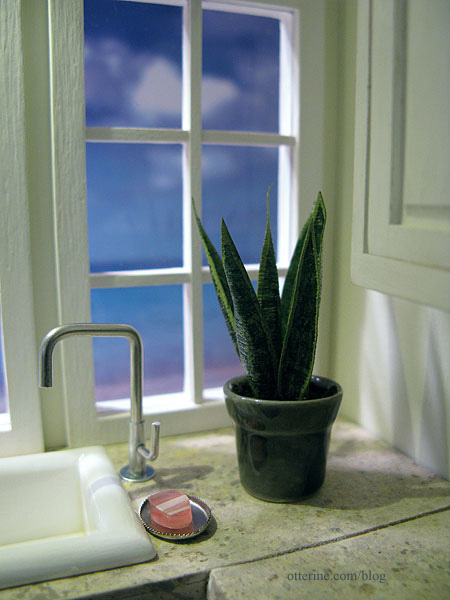
One of the few remaining items from my earlier dollhouse days is a book on making miniature plants out of florist tape called Miniature House Plants by Ruth Hanke. I made an elephant ear plant from a DVD called Master Miniaturists: Flowers & Plants. It has a similar approach.

There are a ton of house plants in this 1988 book, and I know I’ve made at least one of them before. This time around, I opted for the snake plant.

For the dirt, I glued in a piece of styrofoam into a ceramic pot. I then covered the surface with tacky glue and sprinkled on earl grey tea. It has a nice peat moss quality.

In the book example, while the author did include painting the rough stripes of the plant, she didn’t include the wide light green outer edges so I added those based on the real deal. :D I then sealed the leaves with Delta Ceramcoat Satin Varnish.

I poked holes in the styrofoam base, clipped the long wires and glued each leaf in place. The plant stand is a McQueenie Miniatures kit I made previously.

I rather like how this plant turned out. :D I think I’ll be making a few more examples from this book.
Note: for those of you who work in half scale, this book includes both 1″ and 1/2″ scale patterns.
Categories: Flowers, plants, and trees
July 19, 2011 | 0 commentsBaxter Point Villa – main structural changes
I have a separate detailed post on how I added area to the side addition room, which made the addition front wall continuous with the main structure front wall on the lower floor. But, the biggest change I made to the base kit of Baxter Pointe Villa was to replace the upper portion with a taller front wall to create a wraparound deck.
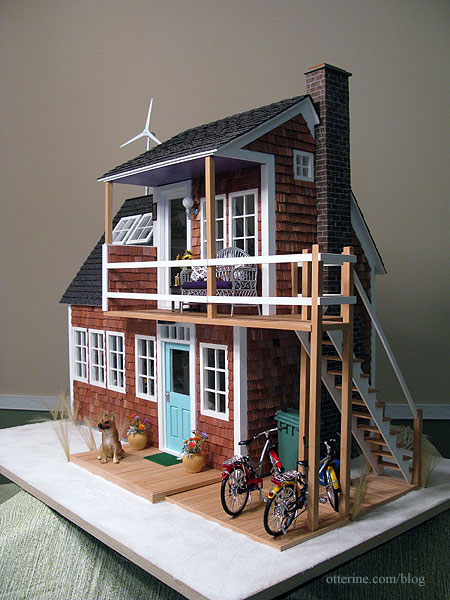
My inspiration for the deck came from a wonderful porch by designer Amanda Nisbet. In fact, her design inspired the cedar shake exterior as well. More on that later.
To get this porch in front of the second floor bedroom, it took a lot of kit bashing. Here’s what the kit and addition originally looked like:
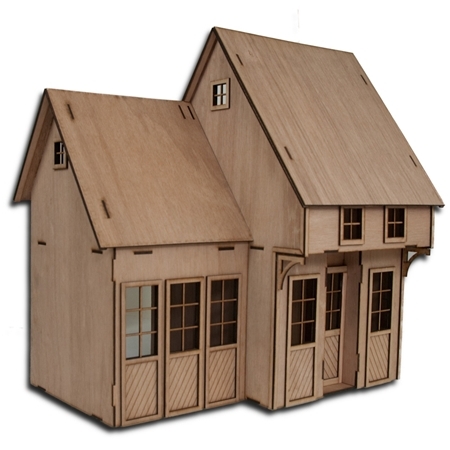
I used the front wall of a second addition kit I bought to make a new front wall in the bedroom.
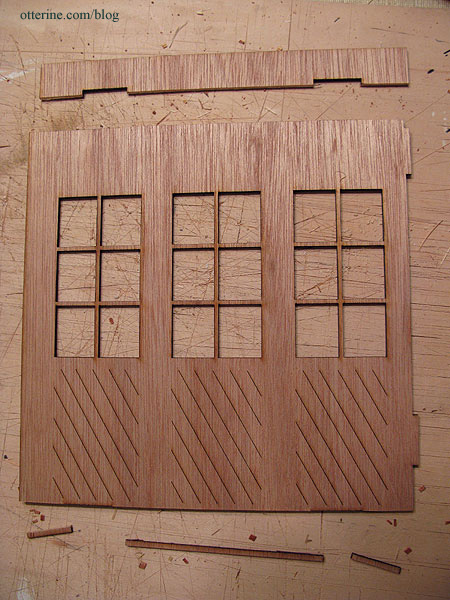
That change created enough room for a small deck. Here you can see how I sheared off part of the outer wall all the way to the floor, making it flush with the new bedroom wall.
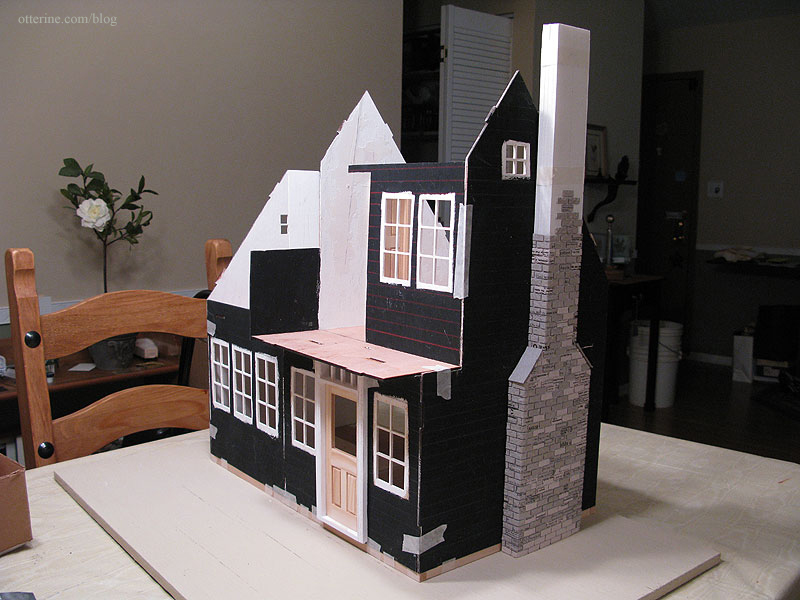
I had to piece the wall around the door since this originally had three window openings. I ended up leaving the mullions out of the French door since I wanted an unobstructed view of the beach.
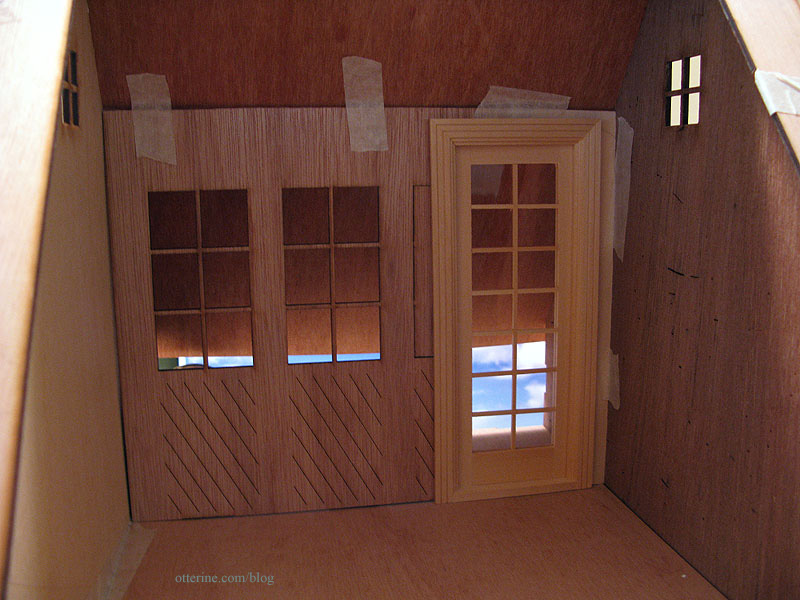
On the end of the deck next to the addition, I cut off the top portion flush with the new bedroom wall and created a short wall just outside the added door. I had to leave some wall there since cutting it off to the floor would have caused problems with the roof line of the addition. I glued a triangle of wood near the front edge of the angled piece to create a square. I padded this low wall with two pieces of 1/8″ thick scrap wood to make it look more realistic in size.
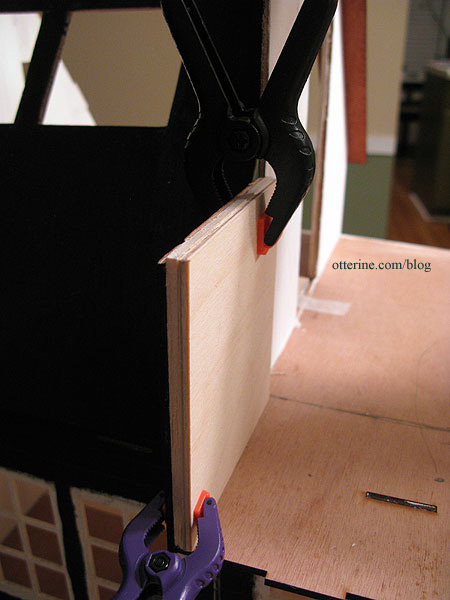
My stairs connected to the deck didn’t quite end up looking like the kit photo, either.
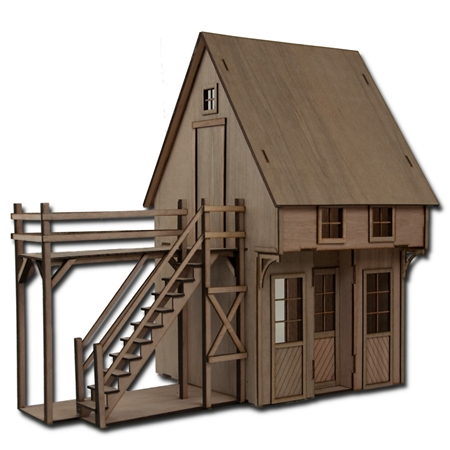
Where to start? I didn’t end up using the posts that came with the kit. I bought a bunch of 5/16″ x 5/16″ strip wood from Hobby Lobby and saved the laser cut wood from the kit for other projects.
I had ordered the base kit plus two side additions, one left and one right, though I planned to use only one or the other — with the second one used for spare parts. I quickly opted for the addition on the left, but that presented an issue with what I wanted to do with the stairs. I needed them exactly the opposite of how they were designed, so I flipped the base and the upper deck upside down. Problem solved! Sort of….
The reason I couldn’t have the stairs next to the main house is that I wanted a chimney. But, even with flipping the stairs, the deck was too long. I cut off a portion of it in the back to clear the chimney and moved the whole assembly flush with the front of the new deck. This meant I couldn’t use the laser cut lines of the stair kit, but I wouldn’t have been able to match those with the new deck anyway.
Here you can see my first chimney mockup and the short wall of the deck before I modified it. I used the original kit posts for planning purposes.
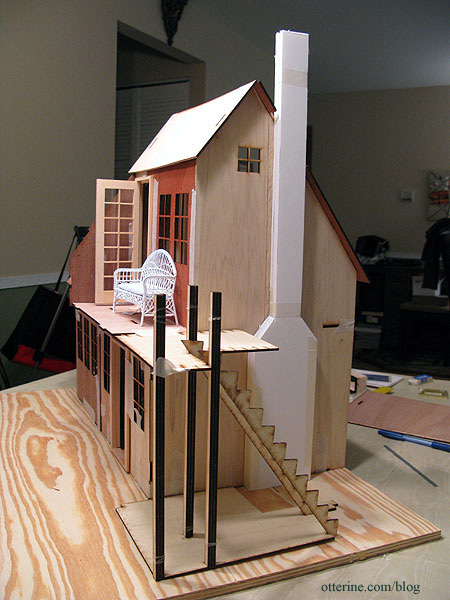
The porch boards were made from Woodsies skinny sticks stained with IKEA antique pine (shown here pre-stain). I followed a front to back direction until I reached the stairs, where I turned the boards the same direction as the stairs. I also flipped the opening direction of the French door to open in to the left instead of in to the right.
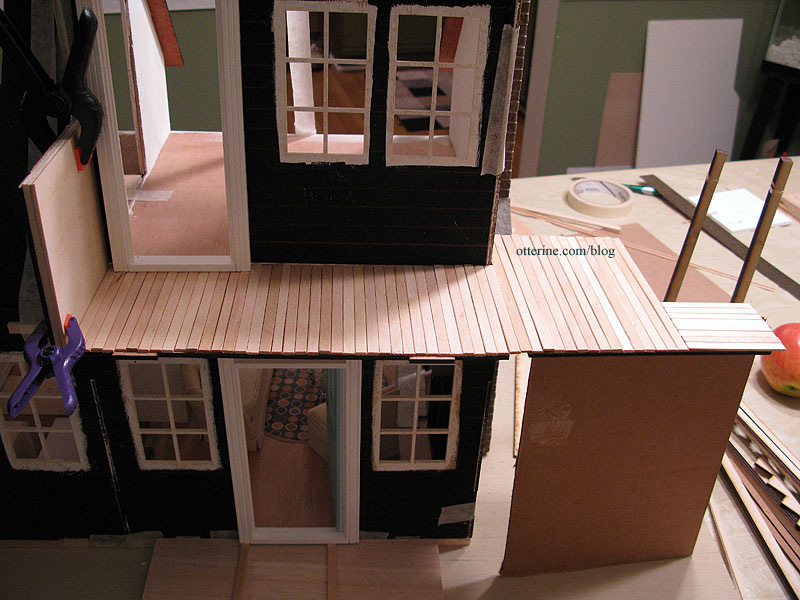
With all of these changes in place, this is how I managed the roof pieces. I used the original roof piece for the bedroom ceiling, cutting it off flush with the side walls from the peak to the top of the new front wall. I also cut it flush with the side walls. I then used 1/8″ thick plywood to make a new top roof and a flat soffit board for the porch that I later covered with strip wood and painted. The white pieces are foam core board cut to fill in between the original house and the new front porch roof line.
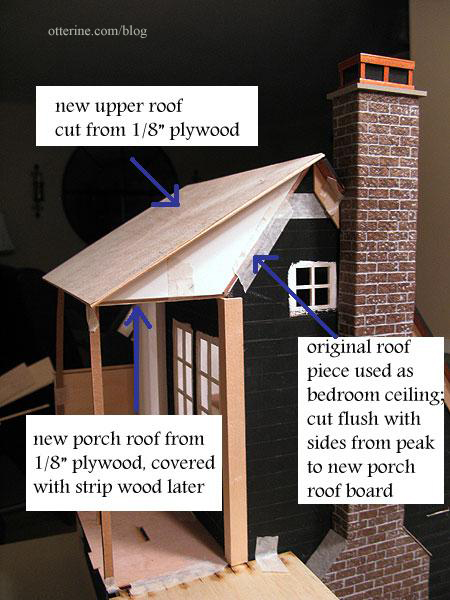
I then cut trim to follow the new roof line.
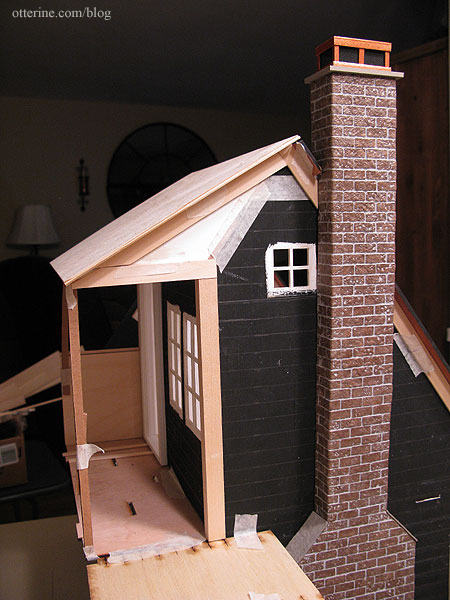
The porch soffit was made using strip wood. I didn’t use skinny sticks here since I wanted a cleaner look than I did for the porch boards. The floor gets more wear than the ceiling. I painted the ceiling Lilac Love by Folk Art. The porch light is a brass fixture I painted silver.
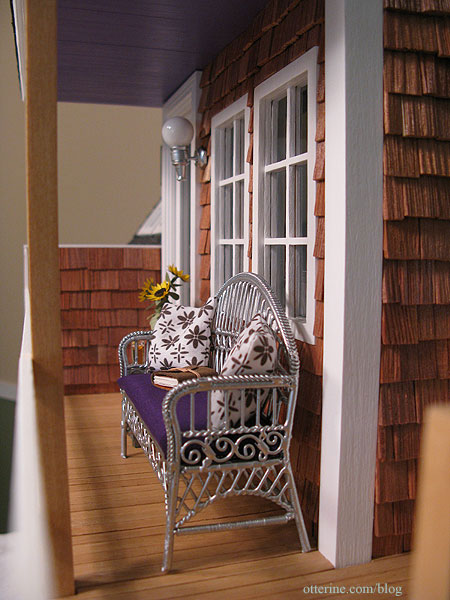
The posts are 5/16″ strip wood stained IKEA antique pine. Sometimes when I work late and get a little punchy, I have to leave myself notes to keep from doing things in the wrong order.
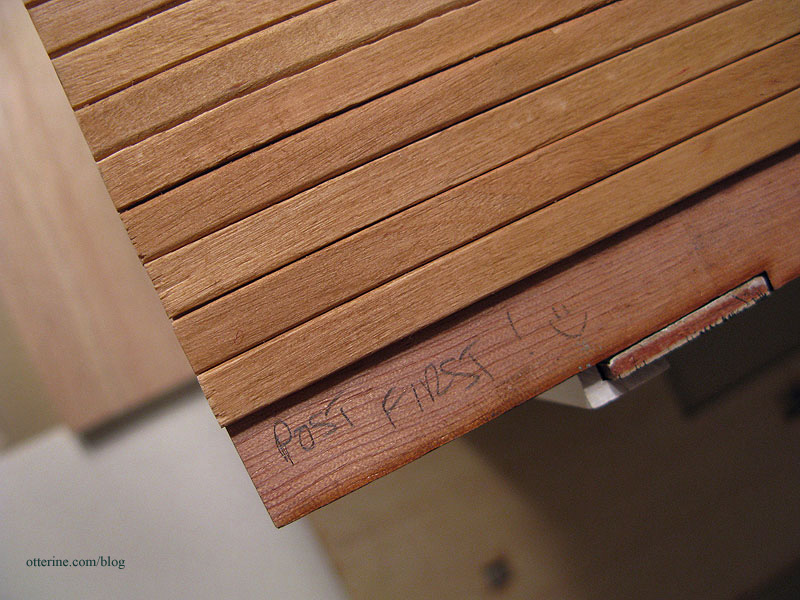
The stair stringer didn’t allow me to use an even number of skinny sticks for the stair treads, but I wanted them to match the deck in color and general appearance. I left off the kit stairs and replaced the treads with bass wood pieces cut using the original laser cut ones as patterns. I stained these with IKEA antique pine as well.
Since the stair stringer was laser cut plywood and the rest was light colored wood, I painted the stringers white. They would not have coordinated with the other stained pieces otherwise.
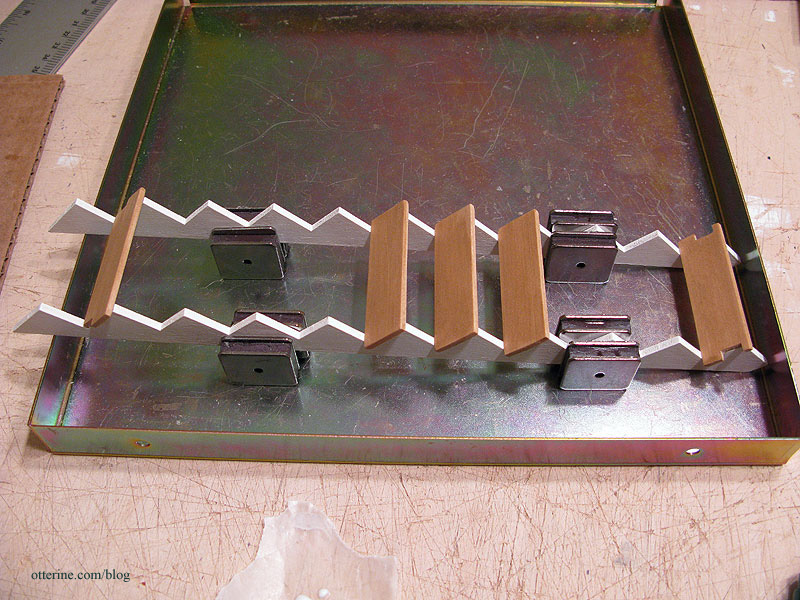
To keep with the white and natural wood color scheme, I used the existing kit laser cut railings and painted them white. I had to cut a few down to size and add some pieces that were meant to make the posts since my deck was a different configuration from the original. I didn’t bother adding the supports under the deck, either. I don’t know if it would pass a structural inspection, but I like the clean lines of my deck and porch. To hide the laser scored lines on the now underside of the deck portion, I used skinny sticks in the same fashion as I had on the top, continuing along the front entryway soffit.
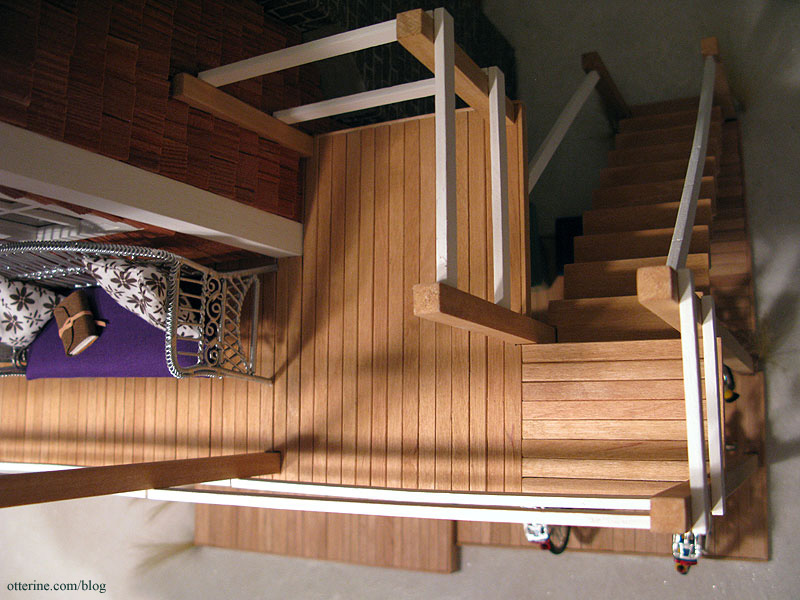
The front lower patio structure is a purchased frame. When I’m on a deadline, I love shortcuts that cost $1.49! I covered this with skinny sticks stained IKEA antique pine.
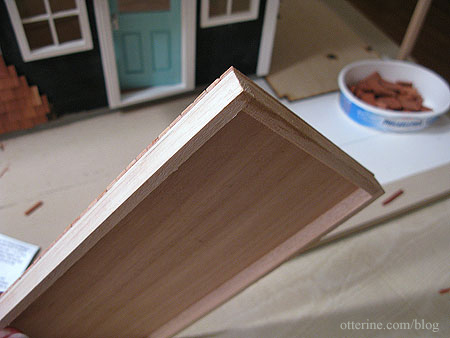
The lower side deck is made partially from the original Greenleaf stairs kit. In order to have the side deck meet up with the front deck, I added a piece of 1/8″ thick balsa wood to fill in the missing areas. I then continued the skinny stick coverage on the entire lower side deck. Since skinny sticks come in predetermined lengths, I used some strip wood to break the deck into areas and tried to create a nice pattern for the boards.
To finish off the front deck and lower side deck, I added strip wood stained to match along the outer edges and curved the last board down just under the first step (stairs obviously not shown here).
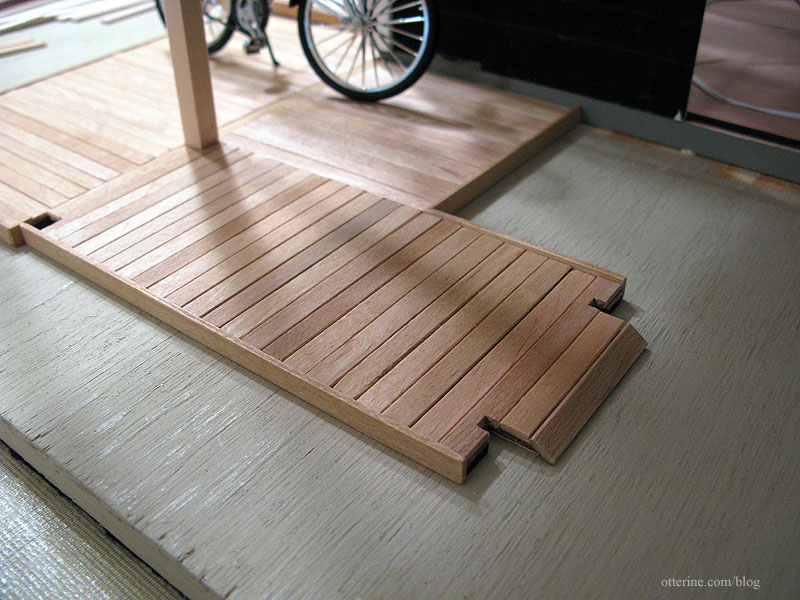
The end result is a light, airy staircase separating the upper and lower decks.
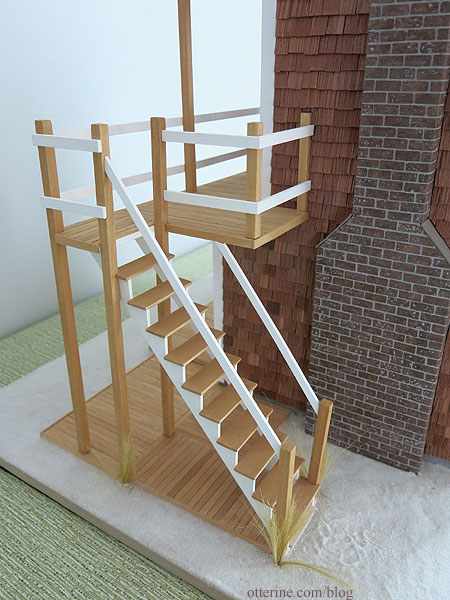
Bedroom
The changes noted above led to a completely revamped bedroom space as well.
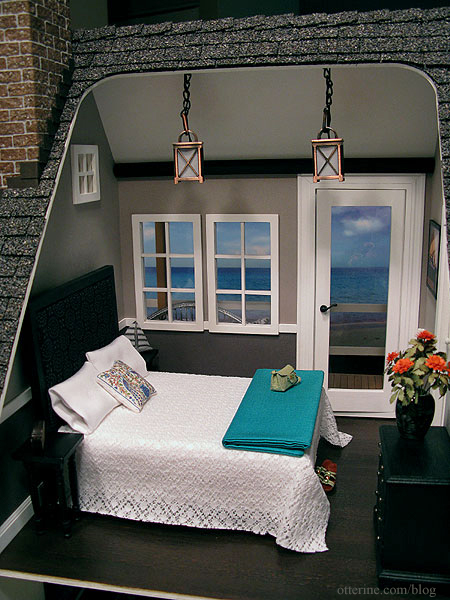
The original bedroom area was an odd shaped room. From the front, there were two small windows and a steep, long roof.
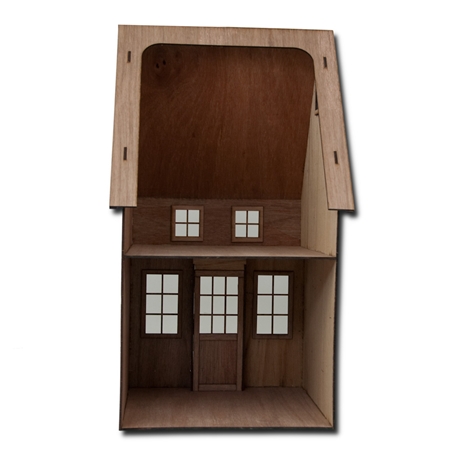
The adjustment in depth on the side addition allowed me to add a working narrow door to the bathroom, and I really like how that turned out.
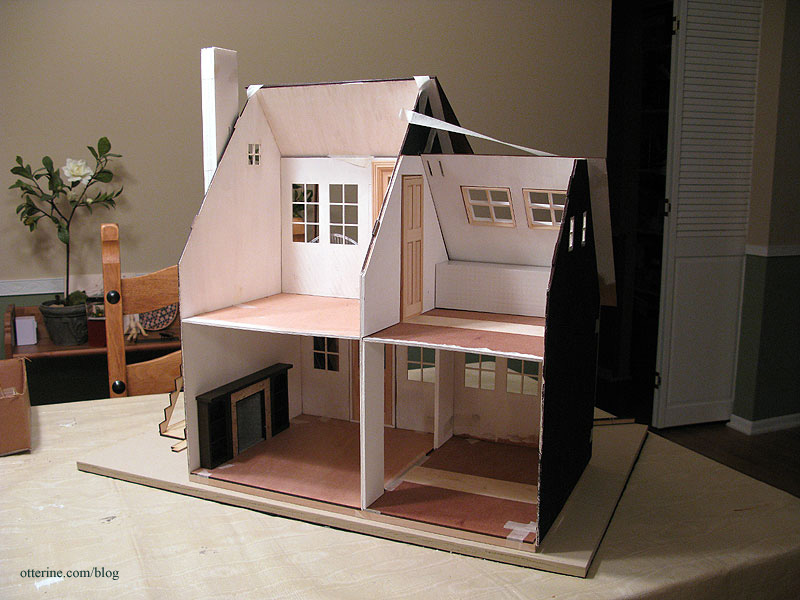
There was still minimal usable room in this part of the structure because of the steep roofline in the back. I was able to put in a bed, two tiny side tables, a small dresser and not much else, but it was much better than the original layout.
Bathroom
As much as I like to zoom in for realism, this house has some nice “dollhouse views” when you show the open back.
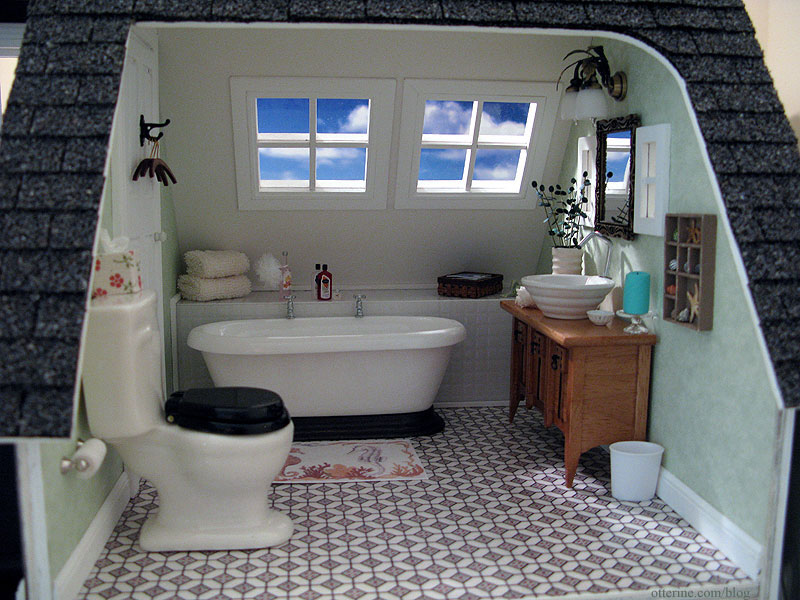
This was a tiny, dark room when I first started planning.
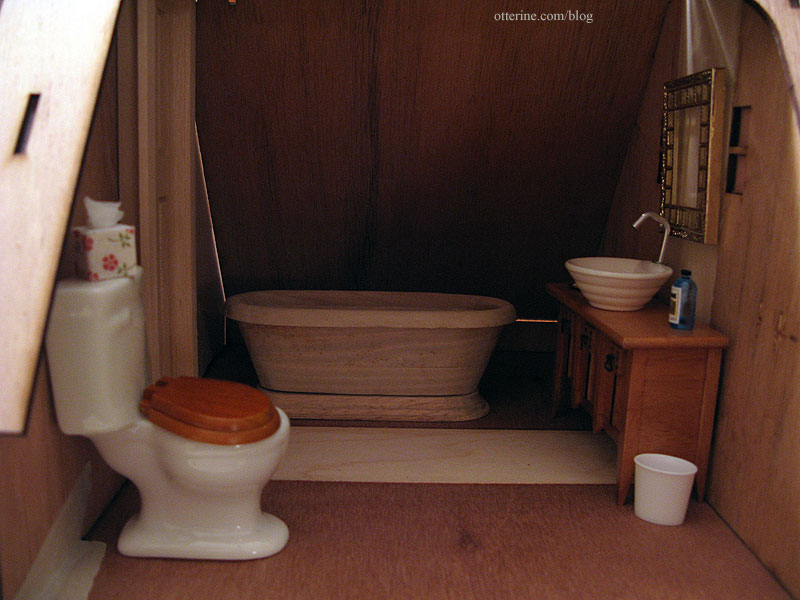
I cut out two skylight windows, which completely changed the feel of the room.
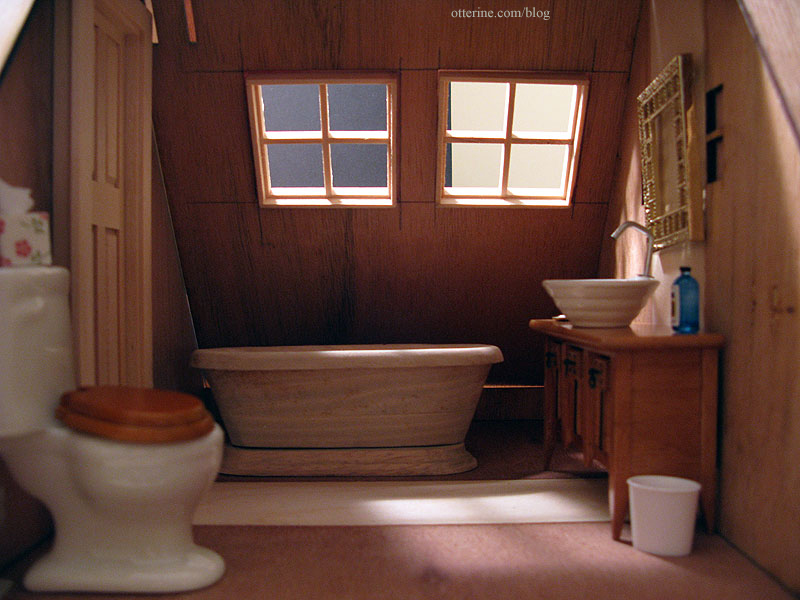
To install a working narrow door, I padded the wall separating the bedroom and bathroom with 1/8″ plywood to solve the problem of the wall being too thin for the ready-made door.
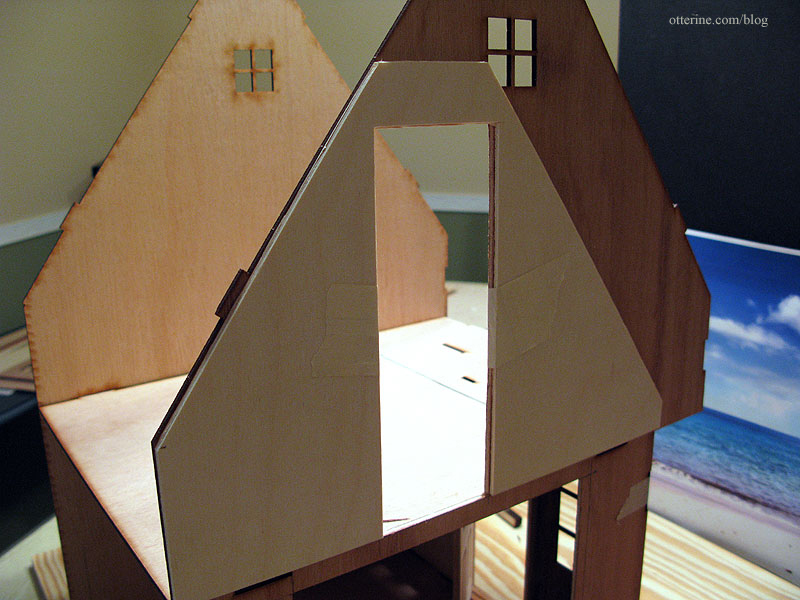
Because the room has a steep angle on the window wall, I built a wall shelf from basswood and foam core board that I then primed with white paint. I covered it with pieces of clear plastic tile sheet that had 1/4″ squares embossed in the surface. I used Krylon gloss white spray paint on the underside of the tile sheet and glued to the basswood base. I added tiny wood trim around the edges to finish it off and hide any gaps.
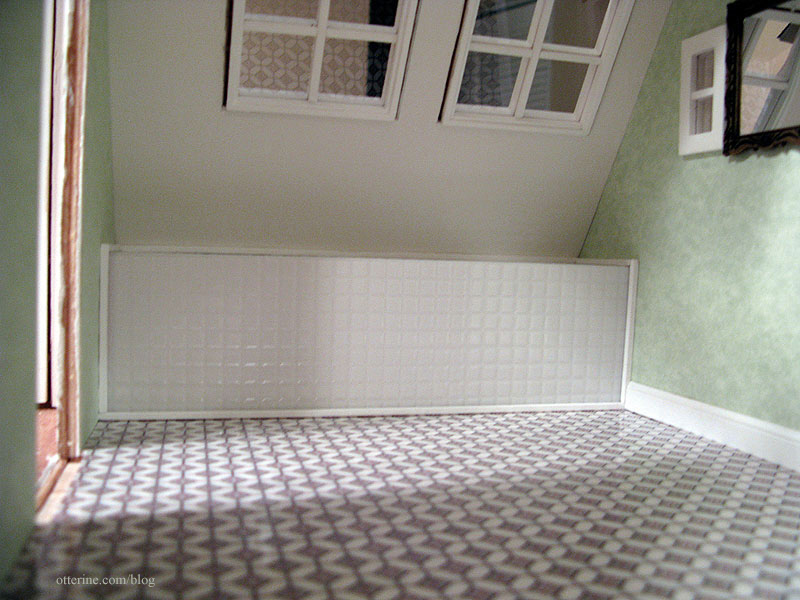
Exterior
The cedar shake exterior with white trim was inspired by Catskill Farms. They have countless beautiful cottages on their blog that are perfect inspirations for miniature homes. I love the way the cedar shake exterior pops with the white trim and grey roof. I was sold!
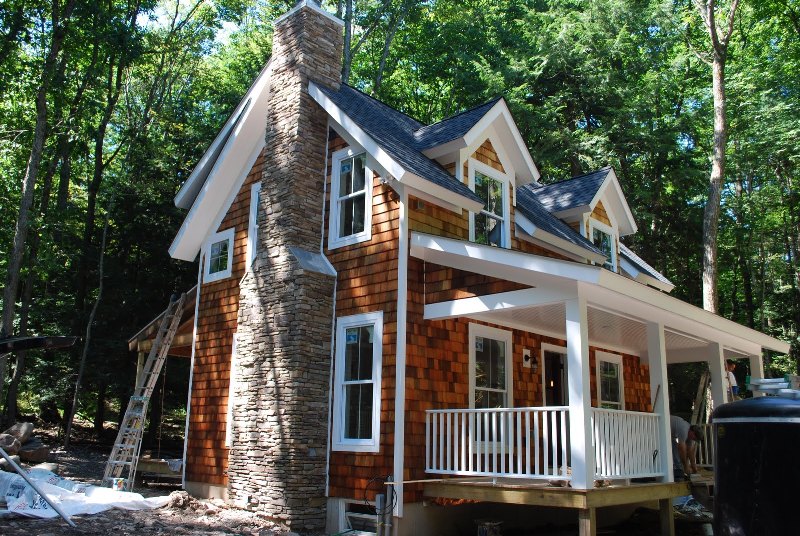
Once upon a time, I had a Dura-Craft dollhouse that never got built and whose pieces were lost to a flood. Some pieces survived since they were stored elsewhere, and included in those miscellaneous parts was a huge bag of cedar shake shingles (say that phrase ten times fast). So, no need to buy materials for the exterior. I made a sample of the exterior finish on a piece of scrap board and positioned it next to the dry fit structure. Whoa! Those windows are a little Amityville Horror, no?
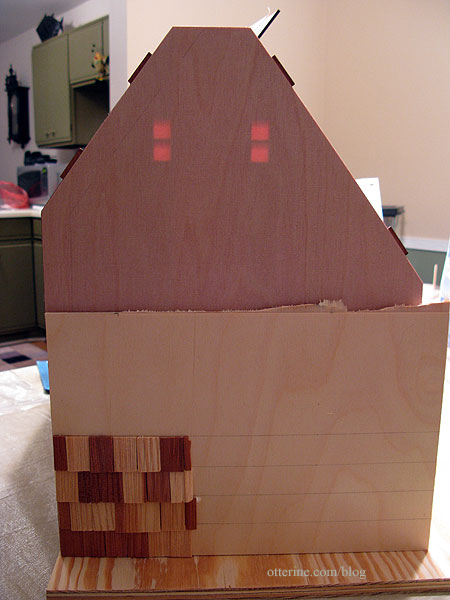
First, I didn’t care for the wide variety of shades in the cedar. It looked like a cedar polka dotted house. So, I spent my lunch hour one day at work sorting cedar shakes into three piles: light, dark and broken. It sounded like I was playing poker, counting out the chips! I used the darker shades since I planned to leave them natural.
Second, I thought the shakes were too big for scale. I looked up the real life size of cedar shakes online and found them to be pretty close to exact 1:12 scale. But, for looks, it just didn’t work for me.
So, I commenced to splitting 1,700 cedar shakes individually by hand. I first split them lengthwise to a width of 1/2″ with an Easy Cutter, and it was easy. I then split them across the grain to a height of 3/4″ with the Easy Cutter, which was not easy. Even with a new blade, the shakes were hard to cut across the grain and were prone to splitting. But, the end result was a better scale match and well worth all the work. This is also one of the most forgiving finishes I’ve worked with so far. Unevenness in application and splits in the wood add to the realism instead of detracting from it.
In addition, it was easy to remove and then replace a section of shingles when I accidentally cut my wiring while installing the kitchen floor. With siding, I would have had to tear a lot more out than the 2″ x 3″ section that I did. After the repair, the new shingles just slipped right into place as though it had never happened. :]
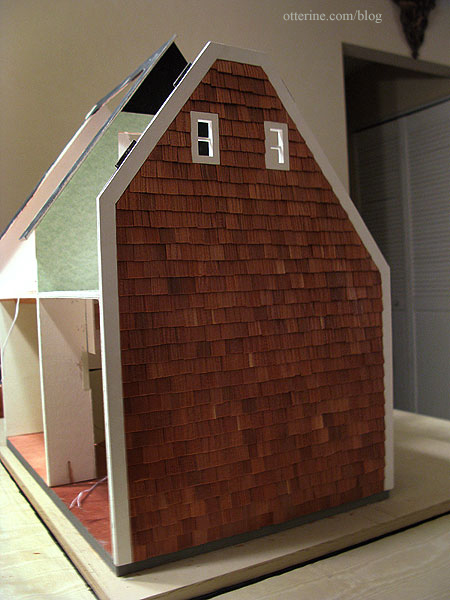
I put the roof of the addition on and shingled that with grey asphalt shingles by What’s Next before applying the cedar shakes on the adjacent wall. There are a number of cedar shake houses in my area, so I was able to see some real life examples of how to handle some of these structural challenges.
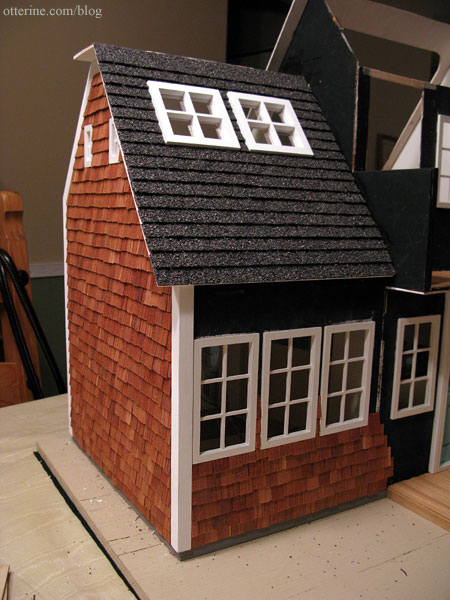
The back roof piece of the addition was a challenge. I don’t know if it was my alteration of the design or just a stubborn warp in the outer wall of the addition, but I could not get the main house roof, the new flat top roof I put in and the addition roof to square up. Finally, I just attacked it with duct tape, and that worked! There is still glue at the joins, but the duct tape is the main support for the bond.
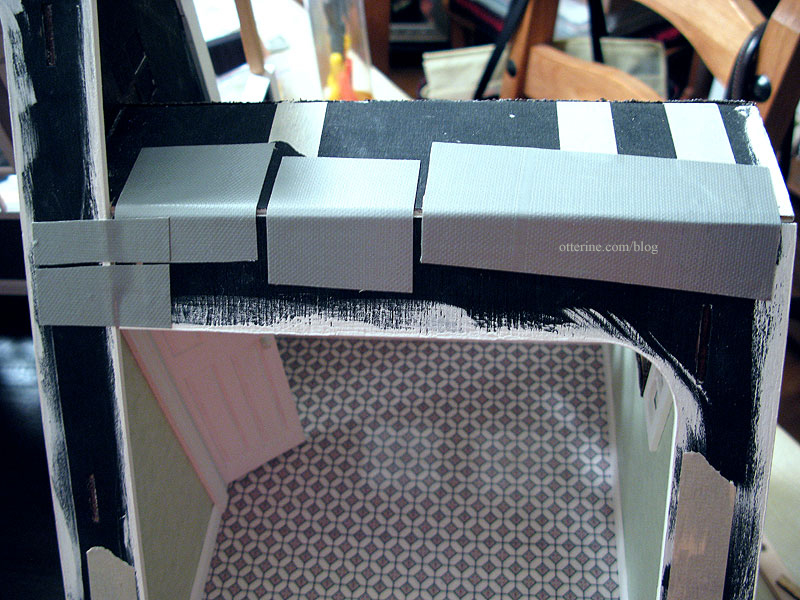
I then created a parapet on the flat top portion using some of the left over kit wood from the stair posts. Inside this wood frame, I painted a piece of cork sheet to simulate the tar and gravel covering. I used Quick Grip glue to attach the shingles and cork piece of the upper roof and had no problems with those things adhering, which was my only concern in using duct tape.
Now, I can’t take credit for even knowing what a parapet was…that was all mom’s influence. I had no idea how to finish this part of the roof until she came up with the idea. Hooray for mom!!! The wind turbine I added later is from ELF Miniatures.
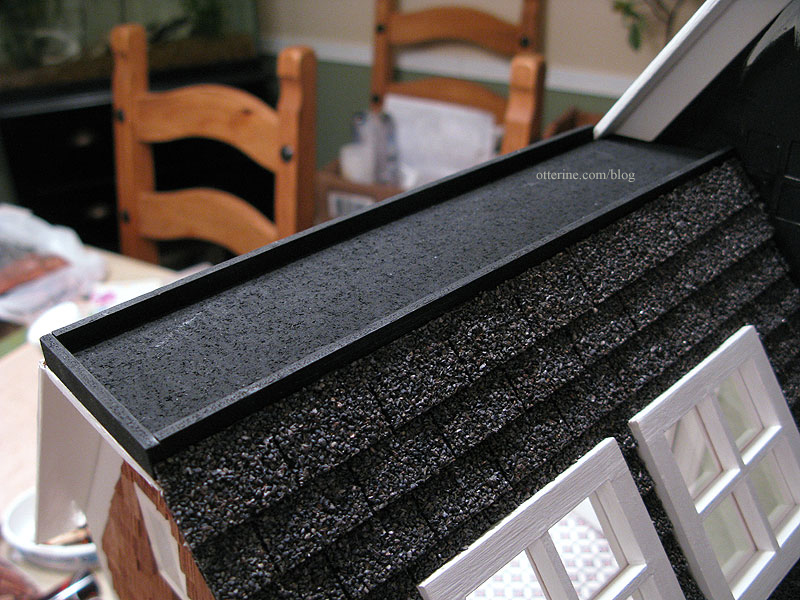
Categories: Baxter Pointe Villa
July 6, 2011 | 0 commentsSaltwater aquarium in 1:12 scale
One of the main features of Baxter Pointe Villa is the saltwater aquarium room divider. This post shows the process I followed for my test tank and this final tank below.
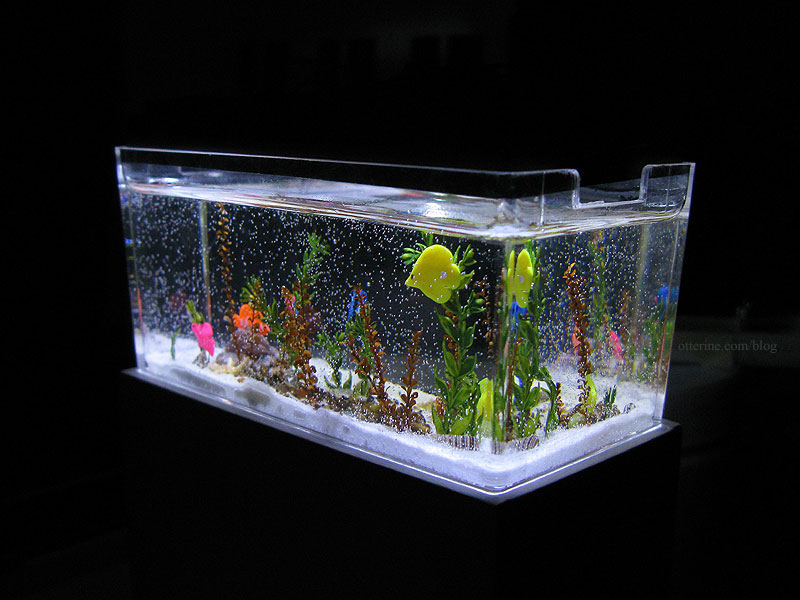
There are several miniature aquariums on the market, some with lighting. In fact, I had one in my childhood dollhouse, though I lost track of it a long time ago. Additionally, there are miniaturists out there who have made their own fish tanks. There’s a wonderful tutorial on the Greenleaf forum for just such a tank.
I wanted to go one step further and make an elaborate saltwater tank with bright, vibrant fish and custom lighting. My inspiration for the overall size and feel of the aquarium came from various real life tanks where the aquarium is mounted in the wall and often serves as a room divider. Very posh. (For real life examples, see Fish World.)
While I did have a few smaller acrylic boxes on hand, I wanted a larger tank…something that would be better suited as a room divider than a fish tank in the corner. I found these boxes, the original purpose of which was to display diecast cars. They measure approximately 4″ L x 2″ H x 2″ D each, though the usable area is shorter since there is a noticeable lip around the top that would detract from the illusion of a real life sized aquarium. Ten dollars for five tanks gave me five attempts to get it right, though I think if it had taken me five attempts I’d have given up around three in a fit of tears and curse words.

It probably would have been better if I had a tank that were tall instead of short and more straight-sided, but I think it works well for what I intended.
Interestingly enough, the bases seem very well suited to aquarium hoods when turned upside down. Remove the knobs on top (or not), add a quick coat of paint, and you’re all set. They even have pre-drilled holes if you wanted to add lighting.

Since I had never worked with resin water before, I decided to do a test tank. I started with white sand I bought at the dollar store. I figured I would need to glue everything in place before adding the resin water, so I experimented with several different methods for gluing the sand in the tank.
I used a mixture of sand, glue and paint. For the gravel, I used gemstone beads that I smashed with a hammer into finer bits. I used the same glue/paint/sand techniques to attach the gravel to see which worked the best. Here’s the result of those multiple techniques.

I ordered some tiny, tiny, TINY shells from Ronni at Marco Island Shells, and in my package she included a bunch of slightly imperfect shells. I dipped a few in glue and pressed them into place. Actually, these aren’t the smallest she carries…she has micromini shells, too!!! :D

Look at all the intricate detail! Isn’t the natural world a remarkable thing? :]

I found some great plastic plants from A Little More in Miniatures at a local mini show. I cut them into varying lengths and used clear glue to attach them to the tank floor.



For the larger stones, fish and other live creatures, I used polymer clay. Since this was a test tank, I didn’t put a whole lot of effort into the sculpts before baking. Some were baked attached to rocks, while others were glued in place after baking. I love Sculpey Bake N Bond! Just a dab really holds so you don’t mar your creations by pressing them together.

I bought two sea urchin polymer clay molds from Tina at Beadcomber. These were cast from actual urchins and they have wonderful details.

I used the smaller one to create a flat sea creature…sort of a mix between coral and urchin. :] I dusted it with pastels before baking.

The blue fish was painted with metallic Testors paint; the rest were formed of colored clay. The rock the blue fish is on was painted with regular craft acrylic paint. As a final touch, I painted eyes on all the fish with Testors black paint using a sewing pin. The fish were all glued in place with Aleene’s clear gel glue before I added the resin.

I sealed half of the urchin creature with acrylic sealer and added a couple of non-plastic plants just to see how the resin would react with these materials.
Of course, my test tank was looking better with everything I added. Isn’t that always the case? Now, I was worried about ruining it with the resin. But, there was no turning back!

I bought Acrylic Water from Walmart since others who have made these tanks recommended it. It was also way cheaper than other casting resins on the market. It was super easy to use, but I must say finding measuring cups was not easy. Sure, I could have ordered them online, but really…a craft store that sells resin kits should have plastic measuring cups. I ended up buying a pack of 9oz. Chinet cups from Target and made my own measuring cups. :D
The test tank took 6oz. of resin mixture. I filled it to the line around the top to make it less obvious.
The directions said to mix the epoxy with the hardener and stir “until clear.” Well, it was clear but it had streak-like formations in it that I didn’t notice until after it was poured into the tank. I don’t know if that meant I didn’t stir it long enough or if that was just the nature of the resin.

During the first few minutes, some large bubbles rose to the top and popped. Using a toothpick, I dislodged a few that were stuck as well. There were some tiny bubbles left in the resin, but I liked the look of them. That sort of aeration is similar to what a real tank has.
After 48 hours, the resin had hardened and looked good for the most part.

Most of the streaks had disappeared, but there was a halo in the area where I had painted a rock with acrylic paints. Though I wasn’t sure it was a reaction with the resin, I figured it was best to eliminate those paints in the next trial just in case.

Had I intended to display the tank in a cabinet with a backdrop, the halo wouldn’t matter since I could likely disguise it…but I wanted to be able to see it from both sides and the streak ruined the illusion of real water. Still, not bad for a test tank.
For the second and final tank, I skipped the sea urchin creature and instead added two starfish, also from Ronni at Marco Island Shells.

I put in more plants as well as taller plants. I spent a bit more time sculpting the fish and added a bit more detail to them.

I also stirred the resin for close to ten minutes to make sure it was as clear as I could get it before filling it up to the side openings along the rim to take advantage of all the usable space available. I got a few more bubbles this time – probably from too much stirring, but I think it turned out fabulous!
To place it in the wall, I built a base that fits just around the tiny lip on the bottom (shown with the test tank).

I used square posts in the corners for stability.

I built the soffit in the same manner, cutting notches for the thin room divider near the ceiling and adding a brace across the inside to glue it in place. Here it is shown without the back, which was put on after installation.

I bought two cool white LEDs from Evan Designs to light the tank. To diffuse the lighting at bit, I used a recycled report cover with a lined texture to finish the inside of the topper.


And, here is the final tank set in the wall. I love it! I especially love the way the lights pick up the bubbles in the resin.
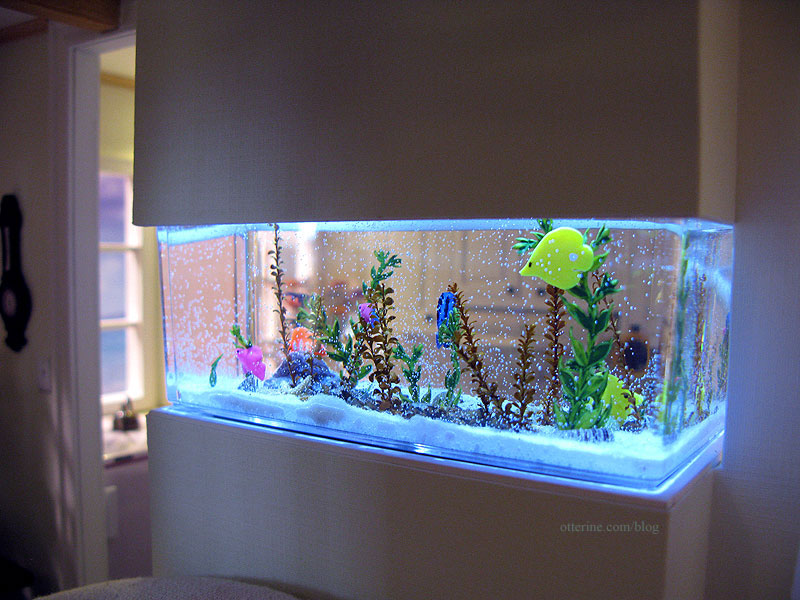
There is a door on the kitchen side of the aquarium soffit that allows access to the tank. I hardwired the lighting, so it’s meant only as a means for the residents to feed the fish! :D
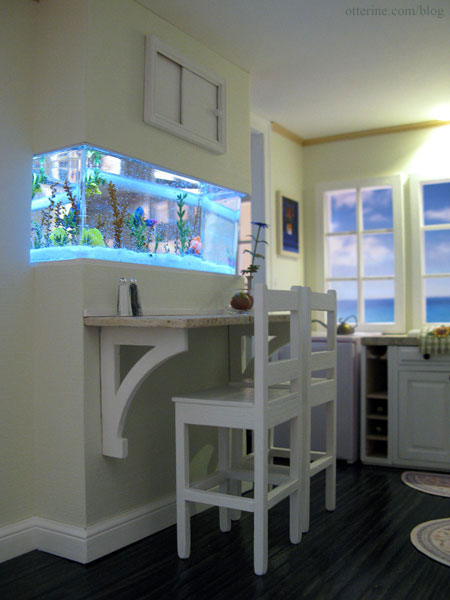
Note: any resin used will likely yellow over time, so use at your own discretion. The resin for the tank made in this post is now very dark yellow.
Categories: Animals and birds
July 3, 2011 | 0 comments
NOTE: All content on otterine.com is copyrighted and may not be reproduced in part or in whole. It takes a lot of time and effort to write and photograph for my blog. Please ask permission before reproducing any of my content. Please click for copyright notice and Pinterest use.






































